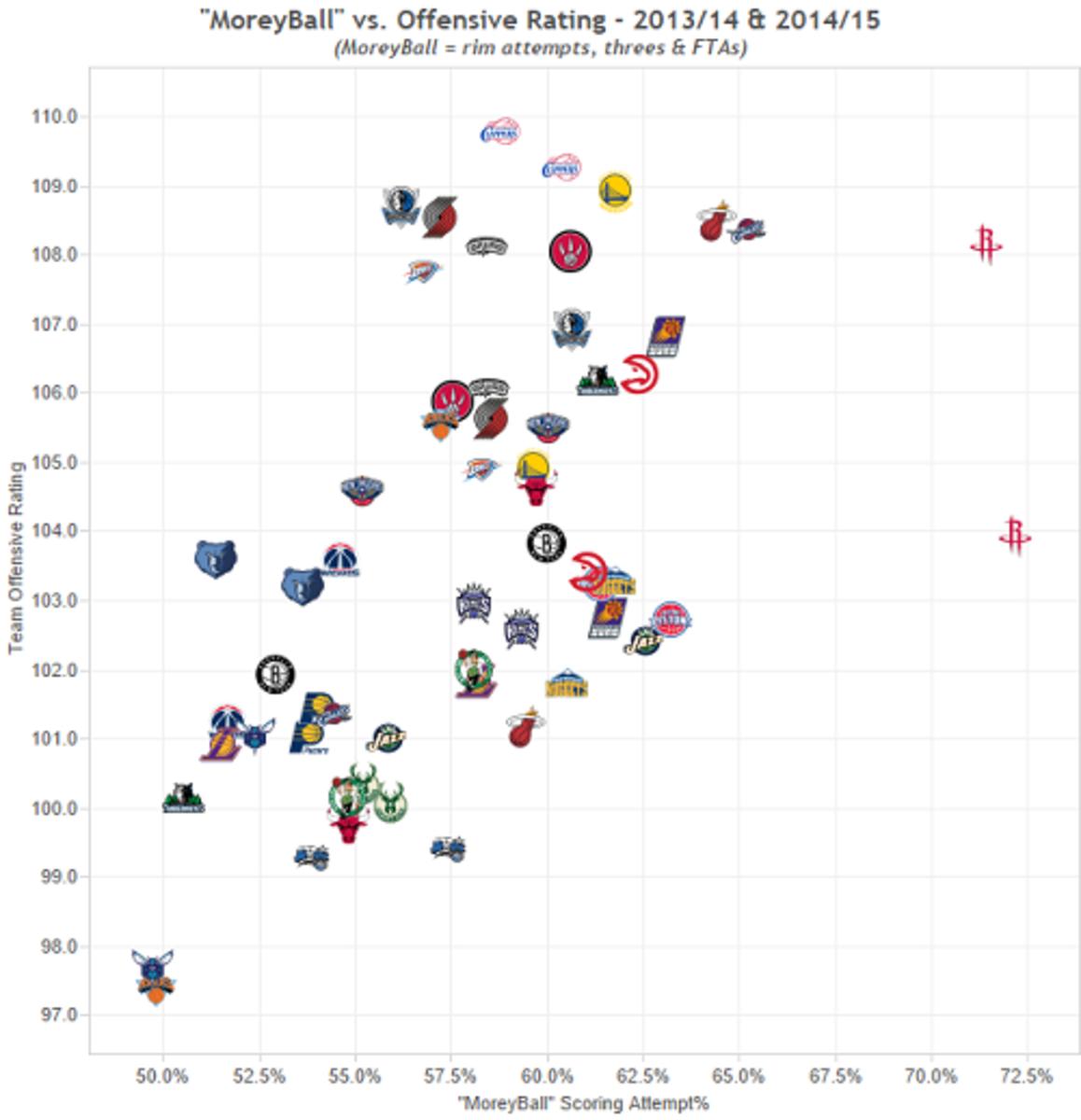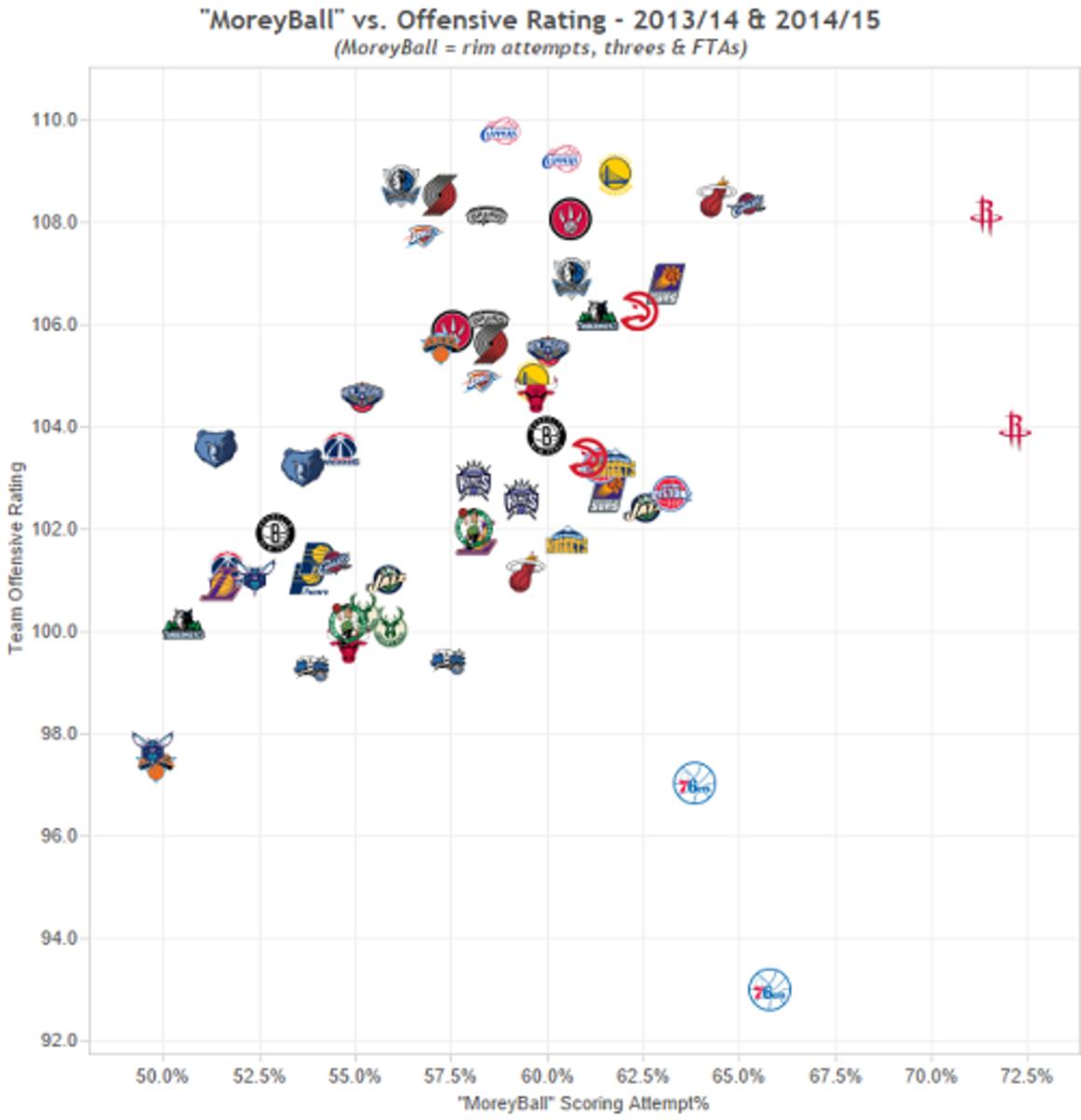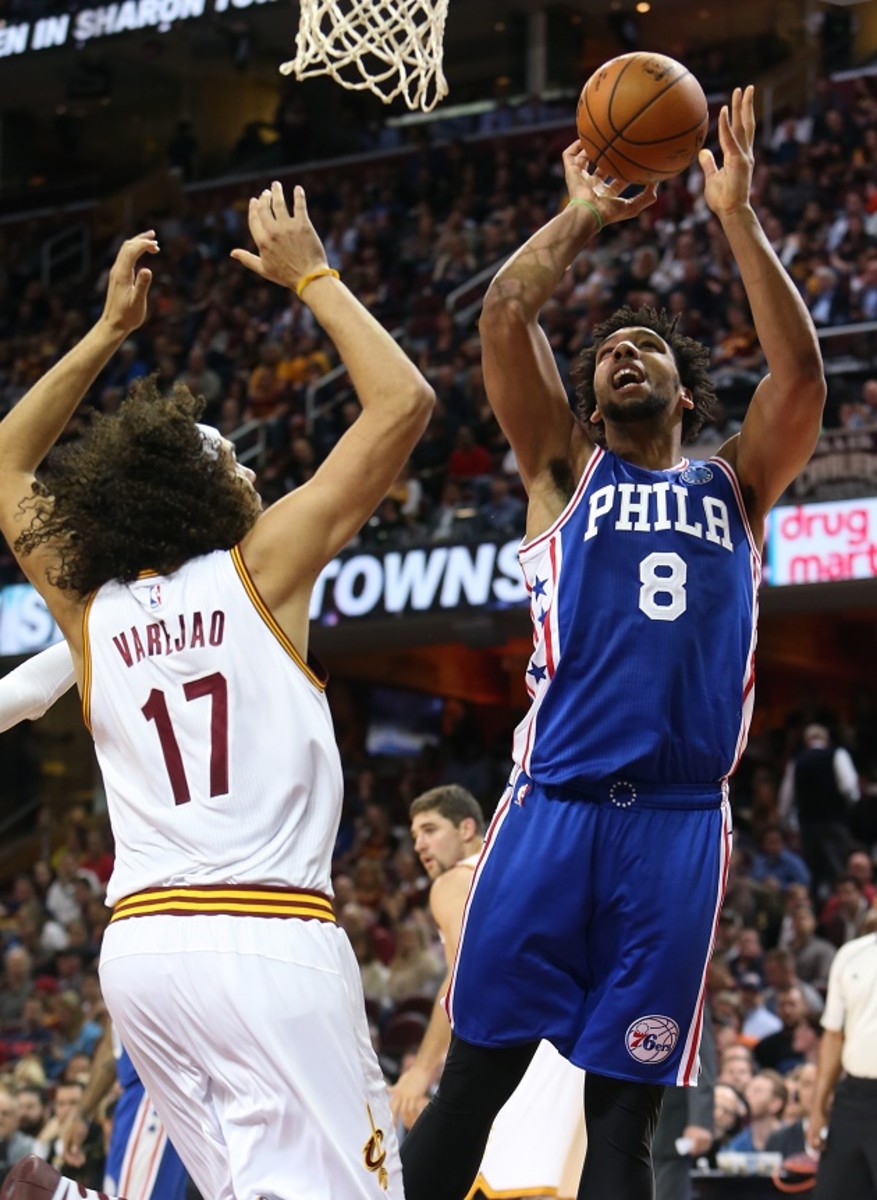For the 76ers, the execution of 'The Process' may be their downfall

The Philadelphia 76ers have a plan. Not just “The Process,” the controversial and largely unprecedented Extreme Franchise Makeover, but on the floor, as well. As befits a team run by Sam Hinkie, steeped as he is in the scientific approach to basketball from his days with the Rockets, the Sixers are extremely cognizant of the benefits of “MoreyBall,” a philosophy emphasizing high-efficiency shots at the rim and from three-point range, as well as free throws.
This is a good plan. The relationship between scoring attempts from these desirable areas and offensive proficiency seems pretty straightforward. Here are the results from the 2013–14 and 2014–15 NBA seasons:

Maybe there are some diminishing returns to this strategy if a team goes to the extremes to which the Rockets unsurprisingly do, and there is variance based on teams’ talent, but the general relationship is clear: The more shots you take from these areas, the more efficient your offense will be.
However, a sharp eye would notice something missing from the above chart:

Despite ranking third and sixth among all teams over the last two years on this MoreyBall scale, the 76ers have put up the NBA’s two lowest team offensive ratings.
So, if the broad strokes are so right, why are the results so wrong? No plan, no matter how solid, can survive poor execution. In the case of Philadelphia, the lack of talent manifests itself in a number of ways.
The 76ers have had the highest turnover rate in the NBA in each of the last two seasons. Despite taking the sixth-most 3-point attempts last season, the Sixers were 29th in 3-point percentage, in large part because they lacked the skill and creativity to open up valuable corner threes. The Sixers finished 23rd in corner-three attempts, a category in which Houston led the league.
Even with several years to infuse new talent, the Sixers currently sit 28th in offensive rating, and and are only fractionally ahead of the Washington Wizards (suffering their own predictable — and hopefully temporary — problems taking care of the ball in their new turbocharged system) in turnover rate. From the perspective of having playing talent, some of the pieces might be in place; Jahlil Okafor looks at times to be every bit the throwback low-post beast advertised since his high school days. But it isn’t nearly enough.
The Sixers' overall roadmap is hard to question. The foibles of teams like the Lakers and Nets, organizations that have sacrificed future draft picks or salary space to acquire and appease downtrending veterans, are exhibits 1A and 1B, demonstrating the wisdom of The Process in very broad terms. A clear-eyed look at the all-too-common mistakes made by franchises in building and rebuilding over the years has shown Philly many of the things not to do.
The Sixers haven’t clung to overpriced veterans or tried to jumpstart their win totals by trading tomorrow for today. They have given their own draft picks all the playing time and responsibility they can handle, and often more. Most importantly, Hinkie has ruthlessly exploited the “one guy away” irrational optimism that tends to pervade the NBA’s middle class of teams, stockpiling extra picks and young players as a result.
In many ways, this ambitious, long-term effort is laudable. By removing all sentimentality and short-term pressure from the equation, Hinkie and Co. have created the closest thing possible to a scientific laboratory in which to construct a contender.
What hasn’t happened is actually building much, so far. Much like the team’s offense, good opportunities have arisen, but too few have been taken. Avoiding mistakes can itself be a mistake if it is used as a rationale to avoid having to make tricky decisions. Though there were muffled chortles at the recent and sizable contract extensions given to Jeremy Lamb (Charlotte) and Terrence Ross (Toronto), is it really better to not have players upon whom such choices have to be made?
We’re through two, soon to be three, seasons. There’s been cap space left unused and possible game reps ignored. In striving so hard to avoid the pitfalls of the past, the Sixers have fallen into a few of their own making. And now with estimates of up to a billion dollars in cap space coming available, avoiding those bad contracts for unproven or middling players will become even more difficult through sheer market dynamics. The value of the cap flexibility the team has so fastidiously protected is less valuable now than it has ever been.
Maximizing future assets with an eye towards a quick ascension is as good a plan as any for going from the bottom to the top in the NBA. After all, few of these blueprints for success are much more beyond broad sketches usually centered on finding a “cornerstone talent” and going from there. And though fortune has yet to smile upon the 76ers, it is hard to dispute that, through their recent draft position and Hinkie’s future-pick collecting, that they’ve enhanced their chances of finding that player.
But maximizing assets means maximizing all assets, and the 76ers have squandered buckets of one of the most valuable of them: time.
Having had years to identify underpriced and underappreciated players to pair with the eventual star man or men, the Sixers have roundly struck out. It is difficult to suggest exactly what a good “hit rate” should be, but after two full years of the 76ers using the bottom end of the roster as an open tryout, it feels like a poor return to have just Robert Covington as a player who likely could contribute to a contending team. (For those who want to suggest players like Jerami Grant or T.J. McConnell, they may well become rotation-level players, but even if so, they will be almost completely fungible with plenty of similar caliber back-of-rotation types available every year.)
None of the explanations for why this has come to pass should fill fans of the team with great confidence. For example, what if Philly has done well to find even that much? That would suggest the flexibility the team worked so hard to achieve is largely fool’s gold. Or, if those players are plentiful, the team has experienced something of a failure of scouting and talent evaluation — tasks which will become no less vital when the time comes to engineer the perfect team.

The K.J. McDaniels situation is instructive here. While he might never become an impactful NBA player, he was widely regarded as a mid-first round talent who somewhat inexplicably fell to the 76ers at the beginning of the second round in 2014. Looking this gift horse in the mouth, Philly still wouldn’t budge from its standard procedure of offering a four-year take-it-or-leave-it team-friendly second-round deal.
McDaniels, rightly, thought he was worth more, and signed the required rookie tender offer, allowing him to become a restricted free agent after his rookie year. The prospect of having to match a big offer for McDaniels caused Philly to deal him to the Rockets for a lesser prospect in Isaiah Canaan and a mediocre draft pick, despite McDaniels becoming an internet darling with his athleticism during his rookie year.
After watching the saga unfold, with McDaniels eventually signing a three-year, $10 million deal with Houston, the question is why that sort of contract would have been anathema to Philly — either before the season, or especially once McDaniels proved himself to be a top-level NBA athlete with a fairly unique ability to protect the paint from a wing position? The Sixers are not only below the salary cap, but also below the salary floor. Again. The cap will rise over $30 million over the next several seasons. If McDaniels on a modest number wouldn’t “maximize” asset value, what possibly could?
McDaniels represents only one of the number of small-bore leaks which, little by little, increase the eventual degree of difficulty of putting better players on the floor. One that gets discussed often is the stigma attached to the franchise for being unfeeling toward players as people. Without re-debating that issue, the accuracy of the perception matters far less than the perception itself. If the 76ers are forced down the road to pay over the odds for complimentary talent, they have not avoided that standard trap of team building, but merely deferred it.
Further, the inability to identify role players might not be a failure of scouting and development, but a reflection of the impossibility of recognizing players who might slot into complementary positions when there is no stable foundation to complement.
This lack of stability also forms a sort of negative feedback loop in creating that foundation. Players who might form part of the new core are not best exploring their NBA skillsets, either. While this likely won't be a problem when and if the team drafts the next Durant or LeBron, it is for less surefire stars who are not being put in the best positions to succeed. This was, to some degree, the case for Michael Carter-Williams, who for all his faults has been a more effective player in Milwaukee because he's being asked to do things that fit his abilities, rather than being forced to attempt those that fall outside his primary competencies.
This is not to say Okafor and Nerlens Noel are doomed, but every bit of defensive nuance Okafor fails to grasp and every quality pick-and-roll rep Noel is cost by not having an competent ball-handling partner costs them a little bit in terms of how good they eventually become. That extra something could easily be what eventually limits Noel to an All-Defensive Team candidate rather than an All-NBA player. You can win with the former, but add in the latter and the task becomes that much easier.
Okafor, in particular, might learn some bad habits just to get by as a post scorer, and that could limit him later. It’s no accident he shot 38.6 percent from the floor in preseason, with his offensive game limited to isolation postups where he received the ball as much as 18 feet from the basket and was forced to batter his way through packed defenses to get shots up. A proven floor general would be better able to reward him with accurate passes when he does successfully rim run in transition or duck into the post from the weakside in the half court. Without that positive reinforcement, will he learn to keep making those movements?
And again, the Sixers have also sacrificed timing. Thanks to the new TV deal, almost every franchise will be flush with cash. When that superstar finally does appear, the 76ers might be forced to pay the Winner’s Curse and overspend for complementary players, just like every failed (and many successful ones, as well) rebuild before them.
It’s unlikely that the Sixers’ grand experiment will ever be repeated. It takes a very unique combination of owner patience and fanbase tolerance. But if it fails, it won’t necessaarily be because it’s a flawed plan. It more likely will be due to the accumulated small failures of its execution.

